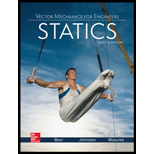
Concept explainers
Find the mass moment of inertia with respect to
Answer to Problem 9.137P
The mass moment of inertia with respect to
The mass moment of inertia with respect to
The mass moment of inertia with respect to
Explanation of Solution
Given information:
The thickness (t) of sheet steel is
The density
Calculation:
Divided the section into three geometric portions as shown below:
- Upper Flange
- Lower Flange
- Horizontal base
Find the mass of the upper flange component using the relation as shown below:
Here, V is volume of component of upper flange and A is the area of the section.
Find the area A of upper flange as shown below:
Here, b is the width of section and h is the height of section.
Substitute
Substitute
Find the mass of the lower flange component using the relation as shown below:
Here, V is volume of component of lower flange.
Find the area A of lower flange as shown below:
Here, b is the width of section and h is the height of section.
Substitute
Substitute
Find the moment of inertia about x axis of upper lower flange section as shown below:
Substitute
Find the moment of inertia about y axis of upper lower flange section as shown below:
Substitute
Find the moment of inertia about z axis of upper lower flange section as shown below:
Substitute
Find the mass of the horizontal base using the relation as shown below:
Find the area A of horizontal base as shown below:
Here, b is the width of section and h is the height of section.
Substitute
Substitute
Find the moment of inertia about x axis of horizontal base as shown in below:
Substitute
Find the moment of inertia about y axis of horizontal base as shown in below:
Substitute
Find the moment of inertia about z axis of horizontal base as shown in below:
Substitute
Find the total moment of inertia
Here,
Substitute
Thus, the mass moment of inertia with respect to
Find the total moment of inertia
Here,
Substitute
Thus, the mass moment of inertia with respect to
Find the total moment of inertia
Here,
Substitute
Thus, the mass moment of inertia with respect to
Want to see more full solutions like this?
Chapter 9 Solutions
Vector Mechanics for Engineers: Statics
- A 10-kg box is pulled along P,Na rough surface by a force P, as shown in thefigure. The pulling force linearly increaseswith time, while the particle is motionless att = 0s untilit reaches a maximum force of100 Nattimet = 4s. If the ground has staticand kinetic friction coefficients of u, = 0.6 andHU, = 0.4 respectively, determine the velocityof the A 1 0 - kg box is pulled along P , N a rough surface by a force P , as shown in the figure. The pulling force linearly increases with time, while the particle is motionless at t = 0 s untilit reaches a maximum force of 1 0 0 Nattimet = 4 s . If the ground has static and kinetic friction coefficients of u , = 0 . 6 and HU , = 0 . 4 respectively, determine the velocity of the particle att = 4 s .arrow_forwardCalculate the speed of the driven member with the following conditions: Diameter of the motor pulley: 4 in Diameter of the driven pulley: 12 in Speed of the motor pulley: 1800 rpmarrow_forward4. In the figure, shaft A made of AISI 1010 hot-rolled steel, is welded to a fixed support and is subjected to loading by equal and opposite Forces F via shaft B. Stress concentration factors K₁ (1.7) and Kts (1.6) are induced by the 3mm fillet. Notch sensitivities are q₁=0.9 and qts=1. The length of shaft A from the fixed support to the connection at shaft B is 1m. The load F cycles from 0.5 to 2kN and a static load P is 100N. For shaft A, find the factor of safety (for infinite life) using the modified Goodman fatigue failure criterion. 3 mm fillet Shaft A 20 mm 25 mm Shaft B 25 mmarrow_forward
- Please sovle this for me and please don't use aiarrow_forwardPlease sovle this for me and please don't use aiarrow_forward3. The cold-drawn AISI 1040 steel bar shown in the figure is subjected to a completely reversed axial load fluctuating between 28 kN in compression to 28 kN in tension. Estimate the fatigue factor of safety based on achieving infinite life (using Goodman line) and the yielding factor of safety. If infinite life is not predicted, estimate the number of cycles to failure. 25 mm + 6-mm D. 10 mmarrow_forward
 Elements Of ElectromagneticsMechanical EngineeringISBN:9780190698614Author:Sadiku, Matthew N. O.Publisher:Oxford University Press
Elements Of ElectromagneticsMechanical EngineeringISBN:9780190698614Author:Sadiku, Matthew N. O.Publisher:Oxford University Press Mechanics of Materials (10th Edition)Mechanical EngineeringISBN:9780134319650Author:Russell C. HibbelerPublisher:PEARSON
Mechanics of Materials (10th Edition)Mechanical EngineeringISBN:9780134319650Author:Russell C. HibbelerPublisher:PEARSON Thermodynamics: An Engineering ApproachMechanical EngineeringISBN:9781259822674Author:Yunus A. Cengel Dr., Michael A. BolesPublisher:McGraw-Hill Education
Thermodynamics: An Engineering ApproachMechanical EngineeringISBN:9781259822674Author:Yunus A. Cengel Dr., Michael A. BolesPublisher:McGraw-Hill Education Control Systems EngineeringMechanical EngineeringISBN:9781118170519Author:Norman S. NisePublisher:WILEY
Control Systems EngineeringMechanical EngineeringISBN:9781118170519Author:Norman S. NisePublisher:WILEY Mechanics of Materials (MindTap Course List)Mechanical EngineeringISBN:9781337093347Author:Barry J. Goodno, James M. GerePublisher:Cengage Learning
Mechanics of Materials (MindTap Course List)Mechanical EngineeringISBN:9781337093347Author:Barry J. Goodno, James M. GerePublisher:Cengage Learning Engineering Mechanics: StaticsMechanical EngineeringISBN:9781118807330Author:James L. Meriam, L. G. Kraige, J. N. BoltonPublisher:WILEY
Engineering Mechanics: StaticsMechanical EngineeringISBN:9781118807330Author:James L. Meriam, L. G. Kraige, J. N. BoltonPublisher:WILEY





